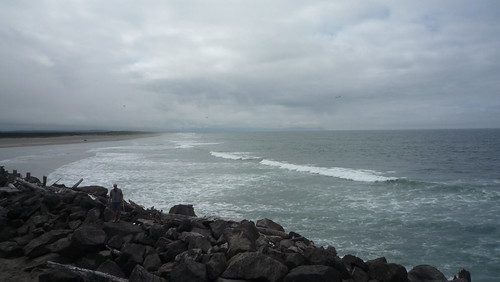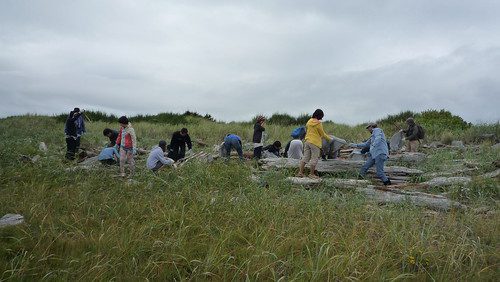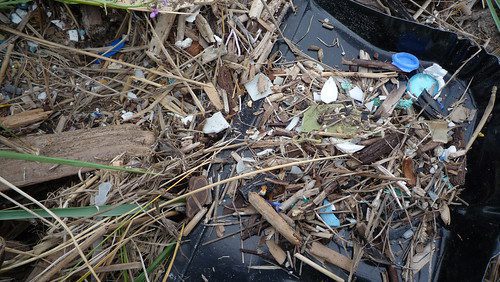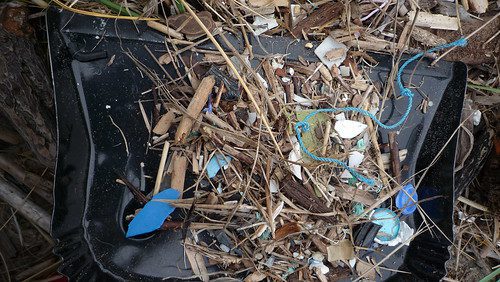

10 days ago I went to the OR coast – around Astoria, the mouth of the mighty Columbia River, with 15 Japanese continuing ed students to survey the beach plastics and look at and for tsunami debris. Oregon is twinned, connected to Japan through a strong east/west current. In addition, long-livin’ plastics suspended in the N Pacific Gyre, the trash vortex bigger than Texas and described as a 300 foot deep cloud of plastic bits, broken into ever-smaller bits by the sun’s UV, masquerading as plankton, and colorful confetti, gets dumped back out, into the currents, and lands on the coastal beaches.
We spent an hour cleaning – if you can call it that – I sat in one place for 45 minutes, overturning sticks and small logs to find an almost-solid layer of post-consumer plastic bits, nurdles (pre-consumer plastic resin pellets), oyster farm tubes, styrofoam nuggets, to mention a few, from the vast polymer taxonomy.

I can’t seem to draw myself away from plastic – what’s been coined The Plastisphere.
To date, though, how the Anthropocene has created new ecosystems in the oceans as well as on land has not been much examined.
Such ecosystems are, nevertheless, emerging—as Tracy Mincer of the Woods Hole Oceanographic Institution, in Massachusetts, and Linda Amaral-Zettler of the Marine Biological Laboratory, also in Woods Hole, describe in Environmental Science and Technology. The malign effect of floating plastic debris on seabirds, turtles and other sea creatures is well known. But, as Dr Mincer and Dr Amaral-Zettler have discovered, plastic debris also provides a new habitat for organisms small enough to take advantage of it.
The two researchers collected pieces of plastic from various sites in the North Atlantic. They then examined each using DNA analysis, and also an electron microscope, to see what was living on it. Lots of things were. Altogether, they discovered about 50 species of single-celled plant, animal and bacterial life. Each bit of debris was, in effect, a tiny ecosystem.
As with many ecosystems, the bottom of the food chain was occupied by things that photosynthesise. These included unicellular algae called diatoms and dinoflagellates, and photosynthetic bacteria known as cyanobacteria. Usually, such creatures swim freely in the ocean. They therefore have to work hard to stay near the surface, where light for photosynthesis is abundant. By hitching a ride on a piece of floating plastic, they can stay near the surface without effort.
I recently found a smitten-inducing blog post by artist Max Liboiron, on a blog called Discard Studies that she co-authors with Robin Nagle and Eric Friedman. I really love the trajectory of the entire post which concludes with:
Our bodies are the newest sink in a long lineage of industrial ecosystems, and can even be considered an extension of the Plastisphere.
What do waste ecosystems like the Plastisphere, The Rocky Mountain Arsenal National Park, and our own bodies mean for notions of pollution as they pertain to harm and health? How do they complicate truisms of clean up and restoration? How do they expand the notion of industrial ecosystems as intentional versus unintentional, contained versus planet-wide? Most importantly, how do we re-conceptualize pollution when purity is no longer empirically possible? These questions are becoming more pressing as our current definitions of pollution, founded more than a century ago, are being outmoded by manifestations of pollution in the twenty-first century.

Another post on the subject: Microbes make cozy homes in ocean’s Plastisphere
I also want this book Accumulation: The Material Politics of Plastic, but it’s Routledge, dammit, and they are notoriously, ridiculously expensive ($135!!!)




